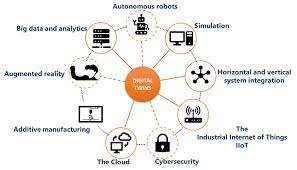
Unlocking Potential: The Transformative Power of Digital Twin Technology
The Rise of Digital Twin Technology: Revolutionizing Industries
In recent years, digital twin technology has emerged as a game-changer across various industries, from manufacturing to healthcare and beyond. This innovative concept involves creating a virtual replica or representation of a physical object, process, or system. By integrating real-time data and analytics, digital twins offer a powerful tool for monitoring, analyzing, and optimizing operations.
One of the key advantages of digital twin technology is its ability to provide a comprehensive view of complex systems. By combining sensor data, machine learning algorithms, and simulation models, organizations can gain valuable insights into the performance and behavior of their assets in real time. This enables proactive maintenance, predictive analytics, and improved decision-making.
In the manufacturing sector, digital twins are revolutionizing production processes by enabling manufacturers to simulate and optimize workflows before implementing changes in the physical environment. This not only reduces downtime and costs but also enhances product quality and efficiency. Similarly, in healthcare, digital twins are being used to create personalized models of patients for diagnosis, treatment planning, and monitoring.
As the Internet of Things (IoT) continues to expand and evolve, the potential applications of digital twin technology are virtually limitless. From smart cities and infrastructure to autonomous vehicles and supply chains, digital twins offer a new paradigm for innovation and optimization. By harnessing the power of data-driven insights and virtual simulations, organizations can unlock new opportunities for growth and competitiveness.
Looking ahead, the widespread adoption of digital twin technology is expected to drive significant advancements in various sectors. As more companies embrace this transformative approach to operations management and decision-making, we can anticipate a future where efficiency, sustainability, and innovation go hand in hand.
Ultimately, digital twin technology represents a paradigm shift in how we design, monitor, and optimize systems in the digital age. By creating virtual replicas that mirror real-world assets and processes with precision and accuracy, organizations can unlock new possibilities for performance improvement and innovation.
Five Key Advantages of Digital Twin Technology: Revolutionizing Maintenance, Operations, and Decision-Making
- Enhanced Predictive Maintenance
- Optimized Operations
- Improved Decision-Making
- Cost Savings
- Innovation Catalyst
Three Key Challenges of Digital Twin Technology: Complexity, Security, and Integration Hurdles
Enhanced Predictive Maintenance
Digital twin technology offers a significant advantage in the form of enhanced predictive maintenance. By creating virtual replicas of physical assets and systems, organizations can leverage real-time data and analytics to monitor the performance and condition of their assets continuously. This proactive approach enables early detection of potential issues or anomalies, allowing for timely intervention and preventive maintenance measures. As a result, downtime is minimized, operational efficiency is improved, and costly unplanned repairs are reduced. The ability to predict maintenance needs accurately based on real-time insights is a key benefit that digital twins bring to various industries, ensuring optimal asset performance and longevity.
Optimized Operations
By simulating processes and systems through digital twin technology, organizations can pinpoint inefficiencies and streamline operations to enhance performance. This proactive approach allows businesses to fine-tune their strategies, identify bottlenecks, and implement targeted improvements for increased efficiency and productivity. By gaining insights from virtual simulations, organizations can make data-driven decisions that lead to optimized operations and ultimately drive greater success in today’s competitive landscape.
Improved Decision-Making
Digital twin technology offers a significant advantage in improved decision-making by providing data-driven insights that empower organizations to make informed choices leading to better outcomes. By leveraging real-time information and analytics from digital twins, decision-makers can gain a deeper understanding of complex systems and processes, enabling them to identify trends, patterns, and potential issues more effectively. This enhanced visibility and predictive capability allow for proactive decision-making that can optimize performance, reduce risks, and drive innovation across various industries.
Cost Savings
Digital twin technology offers a significant advantage in cost savings by enabling organizations to optimize resource utilization and leverage predictive analytics. By creating virtual replicas of physical assets and systems, businesses can simulate different scenarios to identify inefficiencies and streamline operations. This proactive approach allows for better resource allocation, reduced downtime, and improved maintenance practices, ultimately leading to cost reductions and increased operational efficiency. Predictive analytics powered by digital twins also enable organizations to anticipate potential issues before they occur, minimizing risks and avoiding costly downtime. In essence, the ability to harness real-time data and simulations through digital twin technology empowers businesses to make informed decisions that result in tangible cost savings across various industries.
Innovation Catalyst
Digital twin technology serves as an innovation catalyst by offering a platform for testing new ideas and technologies in a virtual environment. This capability enables organizations to experiment with innovative concepts and solutions without disrupting actual operations or incurring significant costs. By leveraging digital twins to simulate and evaluate different scenarios, businesses can accelerate the development and implementation of cutting-edge innovations, leading to more efficient processes, improved products, and enhanced competitiveness in the rapidly evolving digital landscape.
Complex Implementation
The implementation of digital twin technology poses a significant challenge due to its complexity and resource-intensive nature. Setting up digital twins demands specialized expertise, substantial investment in infrastructure, and advanced software solutions. Organizations must navigate through intricate technical requirements and ensure seamless integration of various data sources to create an accurate virtual representation. This complexity can lead to delays, higher costs, and the need for continuous maintenance and upgrades, making it a barrier for some businesses looking to adopt this innovative technology.
Data Security Concerns
The utilization of real-time data in digital twin technology brings forth a significant con in the form of data security concerns. The integration of sensitive information within digital twins exposes a potential vulnerability to cyber threats and unauthorized access. As organizations rely on real-time data to create virtual replicas of physical assets or systems, the need for robust cybersecurity measures becomes paramount to safeguard against potential breaches and protect confidential information from falling into the wrong hands.
Integration Challenges
Integrating digital twin technology with existing systems and processes can present significant challenges for organizations. Compatibility issues, data synchronization problems, and workflow disruptions are common hurdles that can hinder the seamless implementation of digital twins. Ensuring that the virtual replicas align effectively with the physical assets and operations requires meticulous planning and coordination. Additionally, overcoming technical barriers and ensuring a smooth integration process are essential to maximizing the benefits of digital twin technology while minimizing potential disruptions to daily operations.



